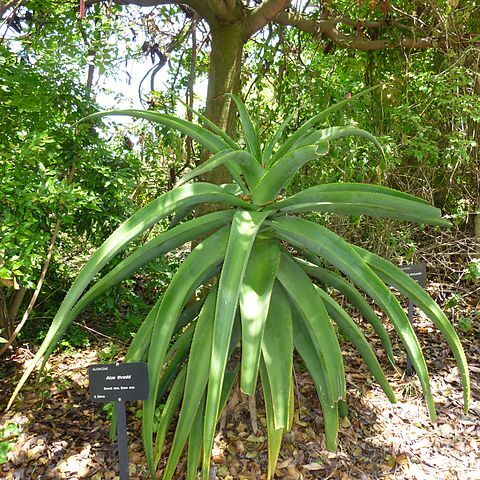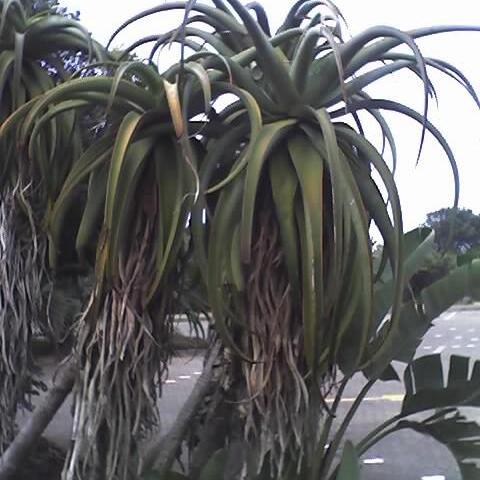Stem simple, usually 1-2 met. high, sometimes up to 4 met, in dense bush, the old dried leaf remains persistent to base of stem. Leaves densely rosulate, dull green to glaucous, up to 1.6 met. long, 22 cm broad at base when pressed flat, gradually tapering to the apex, very deeply canaliculate and 'U' shaped in cross-section, gracefully recurved, with the apices of lowest leaves touching the bearded stem; upper surface without lines or spots, glabrous; lower surface convex, glabrous or with a few thorns in median line to about half-way down, curved forward, more crowded nearer apex, more distant lower down; margins with a very thin narrow reddish or brownish-red edge, armed with small deltoid reddish teeth about 2 mm long, 10-20 mm distant, the interspaces straight. Inflorescence in young plants 1 only with 4-6 racemes, in large fully-grown specimens 3-4 simultaneously, each with 4-8 branches producing a total of 15-25 racemes, the average being 2-3 from a rosette each with 3-6 branches. Peduncle very stout, laterally compressed low down, somewhat sulcate; sterile bracts (below racemes) thin scarious many-nerved, 7 mm long, 15 mm broad at base. Racemes erect, broadly cylindric, slightly acuminate, somewhat truncate, very densely multiflowered, up to 25 cm long, 10-12 cm diam., the buds greenish to orange, open flowers lemon-yellow to pale orange, greenish tipped. Bracts ovate acute, thin scarious white, 9 mm long, 6 mm broad, about 7-nerved. Pedicels 1-2 mm long, green, Perianth cylindric slightly clavate, averaging 25 mm in length (sometimes reaching 29 mm), 6 mm diam. at base, enlarging towards the throat, with the mouth constricted and upturned; outer segments free for two-thirds their length (tube about 8 mm), with 3-5 green nerves confluent at apex, the sub-acute apices of the 2 upper segments falcately incurved, the lowest segment naviculate, and giving the flower a somewhat keeled appearance; inner segments themselves free, but dorsally adnate to the outer for one-quarter their length, broader than the outer, and with 3 congested nerves in median line forming a keel which is lemon in lower half turning green towards apex. Filaments flattened, the 3 inner narrower and lengthening in advance of the 3 outer, lemon within the perianth, the exserted part orange and up-curved. Anthers the 3 inner and 3 outer in turn exserted 15-20 mm Style filiform, palest lemon, with the stigma at length exserted 20 mm and remaining exserted after the perianth dries. Ovary 6 mm long, 3.5 mm diam., lemon to pale green, slightly tapering into the style. Capsule oblong-trigonous, markedly 3-angled, 30 mm long, 16 mm broad across each face, green, turning reddish-brown, for a long time enwrapped with the dried remains of the perianth.
More
Trees; stems simple, 1-2(-4) m tall. Leaves many, 1.0-1.6 x 0.13-0.22 m, deeply channelled, olive-green, upper surface without prickles, lower surface with few prickles in median line. Inflorescence with 4-8 racemes, 500-800 mm tall; racemes cylindric-conical, very dense; bracts ovate-acute, 7-9 x 4-6 mm, 5-7-nerved. Flowers greenish to orange in bud, lemon-yellow to pale orange at flowering, 18-29 mm long, ventricose; outer segments connate in basal third, inner segments free but adnate to outer in basal quarter; pedicels 1-2 mm long. Anthers exserted 4-20 mm. Ovary 5.0-6.0 x 2.0-3.5 mm, lemon to pale green; style exserted 4-20 mm. Fruit ±30 x 16 mm, reddish brown.
Succulent, perennial tree. Stem simple, 1-2 m high, can reach up to 4 m, erect, with persistent dried leaves. Leaves dull green to glaucous, without lines or spots, lower surface sometimes with a few spines in median line, lanceolate-attenuate, 1.6 m long, margins very narrow, reddish or brownish red, with small, reddish teeth. Inflorescence 3 or 4, branched, erect, 0.5-0.8 m high, with broadly cylindric, slightly tapering, somewhat truncate, very dense racemes. Flowers greenish to orange in bud, lemon-yellow to pale orange at maturity, greenish tipped, ± 25 mm long; stamens and stigma well exserted. Flowering time June, July.


